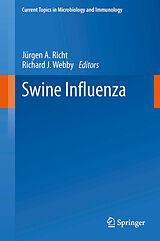Swine Influenza
Format:
E-Book (pdf)
EAN:
9783642368714
Untertitel:
Englisch
Genre:
Mikrobiologie
Herausgeber:
Springer
Anzahl Seiten:
303
Erscheinungsdatum:
08.07.2014
ISBN:
978-3-642-36871-4
The central role which swine have played in the ecology of influenza is set out in this book in 15 chapters within a comprehensive international framework. The result is a 'One Health' perspective on the role of swine influenza viruses (SIVs) at the animal-human-environmental interface. The epidemiology of swine influenza worldwide is now of exceptional importance with the pig potentially acting as a "mixing vessel" where both avian and human influenza viruses can undergo genetic reassortment resulting in the creation of novel viruses that can cross species barriers. The genetic features of SIVs with either limited or efficient spread to and between humans are largely unknown, but the host range barrier between human and swine highlights the fact that adaptation of a virus in one mammalian host does not necessarily mean that it is well adapted to replication in another. However, in 2012 zoonotic transmission of SIV (both H3N2 and H1N2 subtypes) containing the matrix gene from the 2009 pandemic H1N1 virus was reported. These strains appeared to be able to spread more easily from pigs to people than other influenza viruses of swine. Therefore, this multifaceted book has assumed greater significance. Clearly, the dynamic nature and the national and international complexity of SIVs pose challenges for the swine industry as a recurring respiratory disease in swine, and also for public health as a continuing source of zoonotic infection.
Zusammenfassung
From the first detailed clinical description of the disease in the Midwestern United States in 1918, to the isolation of the causative agent, the first of any influenza virus, in 1930 to its role in the genesis of the 2009 human pandemic, swine have played a central role in the ecology of influenza. Although not considered the major natural reservoir for influenza A viruses, swine are host to a limited but dynamic assortment of viruses. A number of subtypes of influenza A viruses of human and avian origin, including H1, H2, H3, H4, H5, H7, and H9, have been isolated from global swine populations. Most of these isolations have, however, been limited in number and it is only H1 and H3 influenza viruses that are known to have formed stable lineages in swine. In this respect, swine influenza viruses (SIV) are similar to their counterparts in humans where H1 and H3 viruses have also been maintained. The nature of these H1 and H3 viruses differ between the two host populations, however, and, as discussed throughout this book, are even different in swine populations in different geographic regions of the world due to multiple introductions of avian and human influenza viruses.
Inhalt
Preface.- Overview of influenza viruses.- History of swine influenza.- Genetics, evolution and the zoonotic capacity of European swine influenza virus.- History of swine influenza virus.- Clinicopathological features of swine influenza.- Diagnostics and surveillance for swine influenza.- Contemporary epidemiology of North American lineage triple reassortant influenza A viruses in pigs.- History and epidemiology of swine influenza in Europe.- Swine influenza viruses: an Asian perspective.- Swine influenza virus vaccines - to change, or not to change: that's the question.- Swine influenza virus infections in man.- Interspecies transmission of influenza A viruses between swine and poultry.- The 2009 pandemic influenza virus: Where did it come from, where is it now, and where is it going? - Pandemic influenza A H1N1 in swine and other animals.- Therapeutics against influenza.- Subject index.

Leider konnten wir für diesen Artikel keine Preise ermitteln ...
billigbuch.ch sucht jetzt für Sie die besten Angebote ...
Die aktuellen Verkaufspreise von 3 Onlineshops werden in Realtime abgefragt.
Sie können das gewünschte Produkt anschliessend direkt beim Anbieter Ihrer Wahl bestellen.
Loading...
Die aktuellen Verkaufspreise von 3 Onlineshops werden in Realtime abgefragt.
Sie können das gewünschte Produkt anschliessend direkt beim Anbieter Ihrer Wahl bestellen.
| # | Onlineshop | Preis CHF | Versand CHF | Total CHF | ||
|---|---|---|---|---|---|---|
| 1 | Seller | 0.00 | 0.00 | 0.00 |
